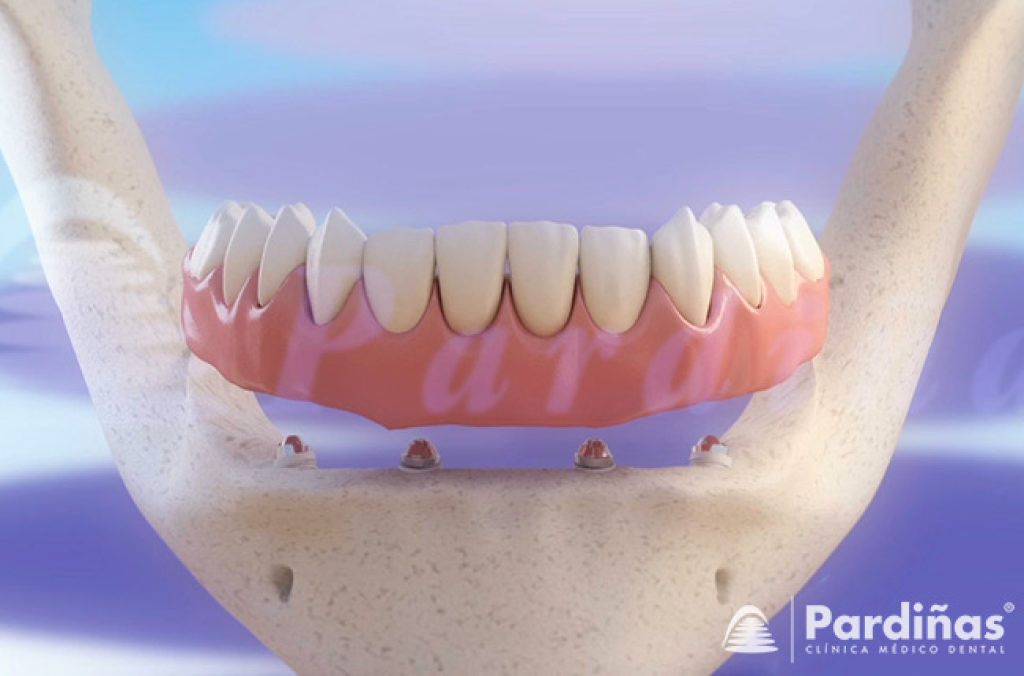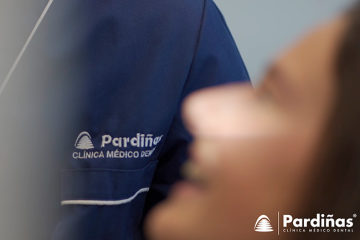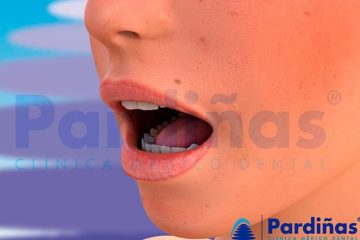Tooth loss not only affects aesthetics, but can cause various oral health problems. Here we show the consequences and possible solutions for missing teeth.
- A) Consequences of not replacing missing teeth
- B) How to replace missing teeth
- C) Are you missing a full dental arch or all your teeth? Consequences and solutions
A) Consequences of not replacing missing teeth
Tooth loss can generate a series of problems if these are not replaced. These consequences can worsen over time.
A1) Short-term consequences of missing teeth
In the short term, the teeth opposite to the missing tooth may slowly extrude or change its position, as they lose contact with the opposing teeth. These dental movements can trigger unwanted contact with other teeth, which can cause cavities, fractures, intrusions, mobility, gum problems, malocclusion problems, TMJ problems, hygiene difficulties, etc.

A2) Long-term consequences of missing teeth
The absence of teeth causes the jaw bone to gradually resorb both in width and height in the long term. It may go from an ideal bone situation for dental implant placement to increasingly worse contexts that can compromise the result of any rehabilitation treatment.

B) How to replace missing teeth
Given the consequences of missing teeth, it is essential to replace them as soon as possible, even if it is temporary while a permanent replacement is prepared.
B1) How to replace a knocked out tooth
Avulsed teeth can be replanted if a series of steps and recommendations are followed in the shortest possible time:
Look for the tooth or pieces of the knocked-out tooth.
Never grab the tooth from the root so as not to damage the cells. Do it from the crown.
Do not wash the tooth or scrape off the dirt.
Place the tooth in a device with a special liquid called Hank's solution, which allows the tooth to be stored for up to 24 hours.
If you do not have this device, insert the tooth into a glass of milk or saline solution.
Go to the dentist as soon as possible.
There is a high possibility of replanting the avulsed tooth following these guidelines, although it will depend a lot on the intensity of the impact and the damage suffered.

B2) Implants, an immediate solution for missing teeth
A solution to permanently replace a missing tooth is the placement of an immediate post-extraction implant whenever the circumstances of the case allow it. Once the tooth is extracted, the bone bed on which the dental implant will be placed is prepared. When this has already been inserted, a healing abutment is screwed onto it, which will remain in place during the period of integration of the implant into the bone, normally between 3 and 4 months. After this time, registrations will be taken to be able to manufacture the dental crown.

B2.a) Immediate implants combined with hard and soft tissues
In certain situations, an immediate implant can also be placed with immediate loading: the prosthesis on the implant is placed simultaneously with the implant. If the patient's situation requires it, it is also possible to perform bone or soft tissue grafts to improve aesthetic and functional conditions.

B2.b) Guided surgery for implant placement
There are digital tools for guided implantology to help in the planning and placement of implants. The procedure begins with obtaining a CBCT of the patient's jaws that will allow visualization of the bone, teeth, and other anatomical structures of interest in 3D. Simultaneously, the impressions of the patient's mouth are obtained and all the models are superimposed using a software designed for this. This computer program allows planning the type, size and position of the implant according to the anatomical characteristics of the patient and the prosthetic restoration that is planned to be performed. Subsequently, the surgical splint that will guide the placement of the planned implant is designed and generated with the drilling sequence corresponding to each case.

B2.c) Implant placement for patients with little dental bone
Under ideal conditions, the implants are placed in the patient's dental bone, which will serve as support for the insertion of this anchor and the subsequent crown. However, whether due to disease, genetic conditions, trauma or bone resorption caused by the absence of a tooth for a long time, some patients do not have dental bone or have an insufficient amount for the correct placement of an implant. In these cases, there are still alternatives such as the use of shorter implants, zygomatic implants, bone expansion, bone regeneration or grafting, or sinus lift procedures, among others.
B3) The dental bridge, an alternative to replace fallen teeth
Although implants are one of the most common solutions for missing teeth, there are other alternatives. One of the most popular is the dental bridge, which also makes it possible to permanently restore missing teeth. For this, it is necessary to prepare the neighboring teeth, which are the ones that will become the pillars of the bridge. Once prepared, some impressions of the teeth will be taken that will be used to design and manufacture the bridge that will later be cemented on the pillars.

B3.a) Advantages and disadvantages of dental bridges
Although this alternative is used to replace missing teeth, it is not innocuous, so it is essential to analyze each case individually and make a correct diagnosis to choose the most appropriate treatment. The main advantage of the dental bridge is that there are certain patients whose mouth does not allow the placement of an implant, so the bridge is presented as the only possible solution. However, it must be taken into account that to make a bridge it is necessary to prepare the adjacent teeth even when they are healthy. In the same way, unlike what happens with the implant, with the bridge there is no stimulus to the dental bone, so it can begin to be resorbed, affecting aesthetics and function. It can also happen that, if one of the abutments of the bridge suffers damage or decay and it is necessary to extract it, a new bridge will be needed, with another preparation of the tooth that acts as an abutment.
B3.b) Maryland, another dental bridge model
The Maryland bridge allows the placement of a bridge without the need to completely file the adjacent teeth. In this case, only the surface of the neighboring parts is slightly abraded. Next, impressions are taken from the patient's mouth and the prosthesis that will be cemented on the previously prepared teeth is designed and manufactured.

B3.c) The cantilever bridge
One possibility to replace two contiguous teeth is the placement of a dental implant with a prosthesis that has an extension, also called a cantilever. This option can lead to problems of fractures of the prosthetic components or loosening of screws due to excess load, so the most common option in this case is the placement of two dental implants with a prosthesis screwed on them. Dental crowns can be made in a unitary way, or united in a single block.

B4) Removable partial denture
The removable prosthesis is another way to restore missing teeth. This prosthesis can be easily placed and removed by the patient. They are generally made of metal and resin and use attachments and hooks that rest on some teeth to obtain retention. This type of prosthesis can be used to replace one or more teeth. Depending on the type and number of teeth to be replaced, a specific design will be made for each case.

B5) Temporary solutions for missing teeth
It is advisable to replace a missing tooth as soon as possible as we have already discussed. However, there are situations and/or clinical cases that do not allow it to be done immediately, so a provisional solution such as the placement of a removable prosthesis or an Essix retainer can be performed. In this case, teeth are not fixed, but can be easily inserted and removed by the patient.

C) Are you missing a full dental arch or all your teeth? Consequences and solutions
Edentulism or total absence of teeth causes a progressive resorption of the maxilla and mandible due to the lack of stimulus from the teeth. The resorption of the maxillary bone will cause the appearance of wrinkles in the nasal and subnasal grooves and the mandible will be displaced forward. The resorption of the jaw bone will cause the appearance of wrinkles in the neck and the jaw will move backwards.

C1) All on four - Full (or partial) rehabilitation with four implants
One way to rehabilitate a toothless mouth is by placing four implants on which a fixed prosthesis will be anchored. It’s mainly indicated in older people where their bite force is diminished. The technique consists of placing four dental implants in both the maxilla and mandible. They are usually inserted between the mental nerve foramen in the mandible, while they are distributed anteriorly to the maxillary sinuses in the maxilla, thus avoiding having to do sinus lifts with grafts to correct the lack of bone in the cases where not enough bone is available, although they can also be distributed along the upper jaw or lower jaw. The immediately loaded provisional prosthesis is then placed for a few months while the implants integrate into the bone. Once they are osseointegrated, the final prosthesis is manufactured and placed.

C2) Full (or partial) rehabilitation with six implants
The placement of six implants in the maxilla or mandible is another way to permanently rehabilitate an edentulous mouth. The process is similar to the previous case, but placing six implants instead of four. This is one of the techniques of choice in young or middle-aged patients. The prosthesis can be hybrid, which is when, in addition to the teeth, it includes part of the false gum, or not have this false gum.
C3) The overdenture on implants
To perform an overdenture on implants is another option to replace missing teeth in an edentulous patient. These prostheses use different types of retentions to be anchored to the implants placed in the patient's bone. The overdenture can be removed by the patient to sanitize it and be easily replaced.

C4) Removable dentures or full dentures, another alternative
The complete removable prosthesis, popularly known as dentures, is a device for the treatment of edentulism that replaces lost natural teeth and rehabilitates bone structures that have been atrophied. That is why it not only serves to improve chewing, but also speech and, especially, aesthetics, which is highly deteriorated in completely edentulous patients.


